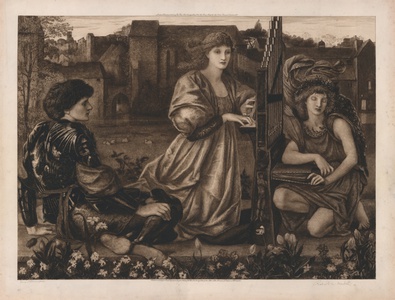| Method | Etching on vellum |
| Artist | Robert Walker Macbeth after Sir Edward Coley Burne-Jones |
| Published | London, Published 1896, by The Fine Art Society (Lim), 148 New Bond Street, w, New York, Boussod Valadon & Co. / Entered according to Act of Congress in the year 1896, by The Fine Art Society in the Office of the Librarian of Congress at Washington |
| Dimensions | Image 385 x 530 mm, Sheet 530 x 656 mm |
| Notes |
Signed in pencil by Burne-Jones and Macbeth. Fine Art Society blind stamp in lower left corner. Robert Walker Macbeth's etching of Le Chant d'Amour, or The Love Song, was but one of the many guises that Edward Burne-Jones' work took. The 1877 painting, from which the etching was taken, was the definitive version of several works that Burne-Jones had dedicated to the theme over a span of fifteen years. The first manifestation appeared in 1862, when Burne-Jones painted a vignette of the scene upon an upright piano that he, and his wife Georgiana, had received as a wedding gift. A preparatory sketch in red chalk appeared in 1863, as did a water-colour in 1865, which was bought by Burne-Jones' patron William Graham. It was Graham who subsequently commissioned the oil painting, though it did not appear in public until the Grosvenor Gallery exhibition of 1878. The subject is thought to have been based upon a refrain from an old Breton song. The lyrics, "Hélas! je sais un chant d'amour / Triste ou gai, tour à tour," translate as: "Alas, I know a love song, / Sad or happy, each in turn". In the print, a portable organ is played by a young woman, whilst the bellows are worked by Eros. To the left, an armoured knight reclines languorously. The architecture that bedecks the backdrop is reminiscent of the background later seen in Burne-Jones' 'The Mill' completed in 1882. Tulips and wallflowers adorn the foreground. The former was a symbol of ardent love and the latter, an emblem of bitterness and conceit. Through his use of flowers, the artist can be seen to represent the paradoxical nature of love as alluded to in the poem. Robert Walker Macbeth (1848-1910) was a Scottish etcher, watercolourist and painter of pastoral landscapes, as well as bucolic genre scenes. Born in Glasgow, Macbeth was educated in Edinburgh and Friedrichsdorf, Germany. He received his artistic education at the Royal Scottish Academy School; and first exhibited there in 1867. Further demonstrations of his work appeared in the northern regions of England, but it was not until Macbeth moved to London in 1870, and was subsequently employed by The Graphic, that his career truly took flight. Macbeth attended the Royal Academy Schools from 1871-1872, and was regularly featured within their exhibitions between the years of 1873-1904. Alongside Francis Seymour Hayden and James Whistler, Macbeth was credited with being one of the foremost exponents of the etching revival in England. This fact was alluded to by his honourary election to various etching societies and institutes towards the end of the nineetenth-century. Sir Edward Coley Burne-Jones, 1st Bt (1833-1898) was a painter and designer closely associated with the later phase of the Pre-Raphaelite movement. Burne-Jones met William Morris as an undergraduate of Exeter College, Oxford, whilst studying for a degree in theology. The pair went on to work very closely together on numerous decorative arts projects including stained glass windows, tapestries and illustrations. Originally intending to become a church minister, Burne-Jones never finished his degree, choosing instead to pursue an artistic career under the influence of Dante Gabriel Rossetti. Rossetti heavily inspired his early work, but by the 1860's his idiosyncratic style was beginning to develop. His mature work, however different in total effect, is rich in conscious echoes of Botticelli, Mantegna and other Italian masters of the Quattrocento. Thusly, Burne Jones' later paintings of classical and medieval subjects are some of the most iconic of the Pre-Raphaelite movement. He was at the height of his popularity during the 1880's, though his reputation began to decline with the onset of the Impressionists. He was created a baronet in 1894, when he formally hyphenated his name. The Fine Art Society was founded in 1876 by a group led by publishing heir William Longman; Marcus Bourne Huish, who became the first Managing Director whilst editing the Art Journal; and Archibald Stuart-Wortley MP. The gallery was first managed by Ernest Brown who later founded the Leicester Galleries. A pioneer of the one-man show, exhibitors at the London premises included Sir John Everett Millais, John Singer Sargent, Frank Brangwyn, Walter Sickert, Walter Crane, George Washington Lambert and Joseph Southall. Condition: Professionally laid to archival board. Heavy inking to knight's armor. Foxing to margins. Creasing to top right corner and lower left sheet edge. Framed in a period frame. |
| Framing | framed |
| Price | £3,250.00 |
| Stock ID | 52216 |

